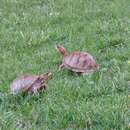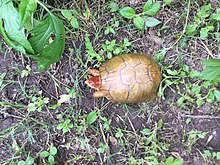fr
noms dans le fil d’Ariane


The three-toed box turtle (Terrapene triunguis) is a species within the genus of hinge-shelled turtles commonly referred to as box turtles. This species is native to the south-central part of the United States and is the official reptile of the state of Missouri.[3]
Three-toed box turtles are so named due to the number of toes on the back feet, but some think that there are some four-toed examples too. However, some speculate that the four-toed individuals are actually eastern box turtle × three-toed box turtle hybrids. Three-toed box turtles have a domed shell which grows to 5-7″ (13-18cm) in length.[4] The highest part of its carapace or upper shell is more posteriorly positioned than in any of the other subspecies.[5] The dorsal and limb coloration is commonly completely absent, although some dark blotches are common in adult turtles. These areas more often being a uniform olive green or tan color. Sometimes, faint yellow dots or lines are visible in the center of each large scute.[6] In the males, the head and throat often display yellow, red, or orange spots.[5][7] Frequently, the bottom shell or plastron is a straw yellow color, and has far fewer dark markings than the plastrons of the other subspecies.[8]
From the west to the east of its range, the three-toed box turtle can be found from eastern Texas to the northern edge of the Florida Panhandle. Its northernmost range is in Missouri and Kansas, while the southernmost one is in Louisiana.[9] Three-toed box turtles interbreed with other subspecies of common box turtles which overlap the borders of this area. An example of this occurs in the eastern Mississippi valley, where this species is difficult to distinguish from the eastern box turtle.[10] Being popular in the pet trade, three-toed box turtles are sometimes found well outside of their home range. It is not known whether such captives when released into the wild have any impact on the local species of such areas. These turtles are adaptive, and are possibly the only box turtle who can live happily in an indoor enclosure.[11]
Three-toed box turtles are omnivores, their diets varying with availability of food sources and the seasons. They are known to eat earthworms, insects, snails, slugs, strawberries, mushrooms, and green-leafed vegetation. They have been observed eating the eggs of quail. All box turtles will prefer live foods to vegetation.
It has also been speculated that these turtles eat poisonous mushrooms, but are not themselves sickened by the mushroom's toxins. Afterwards, the turtles then become poisonous themselves. Carr[12] believes this to be the reason why a group of boys in Mississippi became ill after eating roasted three-toed box turtles.
As pets, they have been reported to eat mealworms, corn, melon, crickets, waxworms, tomatoes, cooked eggs, fruit, and even moist dog food. Diet should consist of approximately 50% plants and 50% animal protein.[4] They can be shy about being watched while eating, and may stop and stare back motionless if this happens. Multivitamin supplement and cuttlebone for calcium are required as part of the captive diet.
Three-toed box turtles are known to migrate seasonally in order to maintain their preferred humidity level. In Arkansas, three-toed box turtles were observed in grasslands in late spring, while in early spring, summer, and late fall they were found in forested areas.[13] During dry times, they dig shallow burrows into leaf litter to conserve moisture. When water is available, these turtles soak for longer periods of time than any of the other subspecies.[10]

Three-toed box turtles require care similar to that of other box turtles, faring best in large, outdoor enclosures. These enclosures should have plenty of room to allow the turtle to burrow, but should also be protected to prevent the turtle from burrowing under enclosure fencing. Indoors, three-toed box turtles should be kept in a large wooden enclosure measuring 6’L x 3’W x 2’H, or otherwise offering roughly 18 square feet of space.
An indoor enclosure should have a high temperature side with a heat bulb at around 85 °F and a lower temperature side at 70-75 °F. Humidity should average between 60-80%. The enclosure should also contain at least one humid cave or hideout for the turtle as well as an area where it can soak. A T5 HO UVB lamp of appropriate strength is required for survival indoors. Peat moss, coconut fiber, and clean topsoil all make acceptable substrates. Desert materials such as gravel or sand would be too dry and difficult for the turtle to dig into, and will cause small scratches susceptible to infections. Many owners simply spray the surface area of the enclosure down at the beginning of the day in order to moisten the material and to increase the humidity of the enclosure.
With good care, three-toed box turtles are capable of living for at least 50 years.[4]
The three-toed box turtle (Terrapene triunguis) is a species within the genus of hinge-shelled turtles commonly referred to as box turtles. This species is native to the south-central part of the United States and is the official reptile of the state of Missouri.
Terrapene carolina triunguis (tortuga de caja de tres dedos) es una subespecie de Terrapene carolina dentro del género Terrapene. Esta subespecie es nativa de la parte sur-central de Estados Unidos y es la tortuga oficial del estado de Missouri.
La tortuga de caja de tres dedos se llama así debido al número de dedos en las patas traseras, pero puede que también haya algunos ejemplares de 4 dedos, sin embargo, estas serían en realidad híbridos con las tortugas de caja del este (Terrapene carolina carolina). Esta subespecie tiene un caparazón abombado, la longitud del caparazón de esta subespecie es de 7 pulgadas. La mayor parte de su caparazón es más posteriormente posicionada que en las otras subespecies. La coloración del dorso y las extremidades es generalmente completamente ausente, aunque algunas manchas oscuras son comunes en las tortugas adultas. Estas áreas son, con más frecuencia, de un uniforme verde oliva o de color tostado. A veces, de un débil amarillo con puntos o líneas visibles en el centro de cada gran escudo. Desde el oeste hacia el este de su distribución, la tortuga de caja de tres dedos se puede encontrar desde el este de Texas hasta el extremo norte de Florida. Su hábitat en el norte se encuentra en Missouri y Kansas, mientras que en el sur se encuentra en Luisiana.
Estas tortugas son omnívoras, su dieta varía con la disponibilidad de fuentes de alimentos y con las estaciones. Se sabe que comen lombrices, insectos, caracoles, babosas, fresas, hongos y vegetales de hojas verdes. Se han observado comiendo los huevos de la codorniz. Cabe señalar sin embargo que todas las tortugas de caja prefieren alimentos vivos antes que la vegetación. También se ha especulado que estas tortugas comen hongos venenosos y que no les afectan las toxinas de las setas venenosas. Se cree que esto provoca que ellas mismas se vuelvan venenosas, esta es la razón por la cual un grupo de niños en Misisipi enfermó después de comer asado de tortugas de caja de tres dedos. Como mascotas pueden comer gusanos, maíz, melón, grillos, gusanos, tomates, huevos cocidos, fruta, e incluso comida húmeda para perros. Pueden ser tímidas a la hora de ser observadas mientras comen.
Las tortugas de caja de tres dedos migran estacionalmente con el fin de mantener la humedad que necesitan. En Arkansas se han observado en las praderas en primavera, mientras que a principios de primavera, verano y otoño se encuentran en zonas boscosas. Durante la época seca excavan madrigueras poco profundas en la hojarasca para conservar la humedad. Cuando el agua está disponible estas tortugas entran en remojo durante largos periodos de tiempo como cualquiera de las otras subespecies.
Las tortugas de caja de tres dedos requieren un cuidado similar a la de todas las tortugas de caja del este (Terrapene carolina), estando mejor en grandes recintos al aire libre. Estos recintos deben tener suficiente espacio para permitir que la tortuga entre en la madriguera, pero también deben ser protegidos para evitar que se escape del recinto. En el interior deben mantenerse en un recinto de madera, por lo menos de 30 galones de una tortuga única. No mantener ningún tipo de tortuga terrestre en un acuario, ya que las tortugas no entienden el concepto de cristal y pueden estar muy estresadas si no ven una barrera visual. El recinto debe tener una zona de alta temperatura con una bombilla de calor alrededor de los 85 °F y una parte de menor temperatura a 70°F. El recinto también debe contener un escondite para la tortuga, así como una área donde pueda disfrutar. Turba de musgo con una humedad alrededor del 80% (húmedo pero no mojado) es el preferido para estas tortugas de caja. También trozos de corteza y otros materiales como la madera. Materiales del desierto, como grava o arena serían demasiado secos y difíciles para escarbar, y los pequeños rasguños son susceptibles a las infecciones. Muchos propietarios simplemente rocian la superficie de la caja en el inicio de la jornada con el fin de humedecer el material y para aumentar la humedad del recinto.
Terrapene carolina triunguis (tortuga de caja de tres dedos) es una subespecie de Terrapene carolina dentro del género Terrapene. Esta subespecie es nativa de la parte sur-central de Estados Unidos y es la tortuga oficial del estado de Missouri.
Terrapene carolina triunguis juga dikenali sebagai Kura-kura Katup Jari Tiga ialah subspesies dari genus Terrapene. Subspesies ini berasal dari bahagian tengah-selatan Amerika Syarikat dan menjadi ikon rasmi negeri Missouri.[2]
Terrapene carolina triunguis juga dikenali sebagai Kura-kura Katup Jari Tiga ialah subspesies dari genus Terrapene. Subspesies ini berasal dari bahagian tengah-selatan Amerika Syarikat dan menjadi ikon rasmi negeri Missouri.